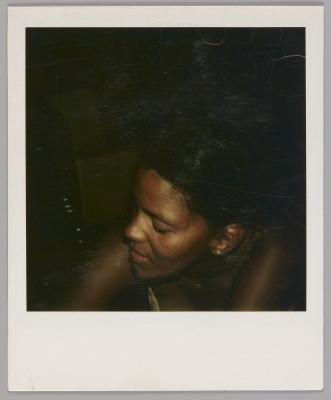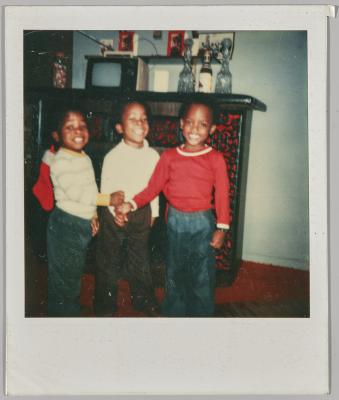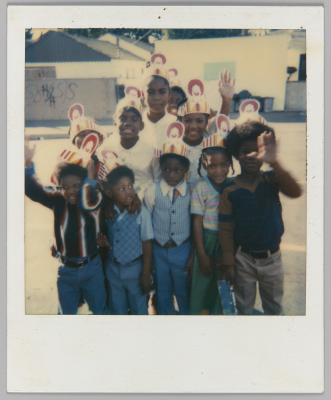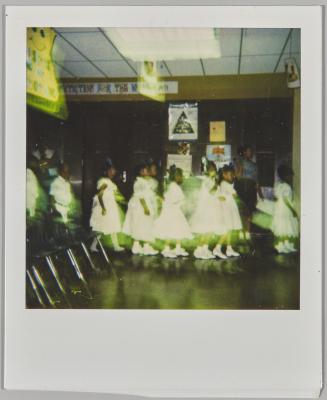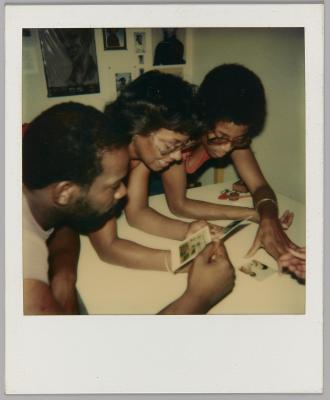Imaging the Subaltern
Black Pen writer Omi Blue's essay in response to What Matters Most: Photographs of Black Life.
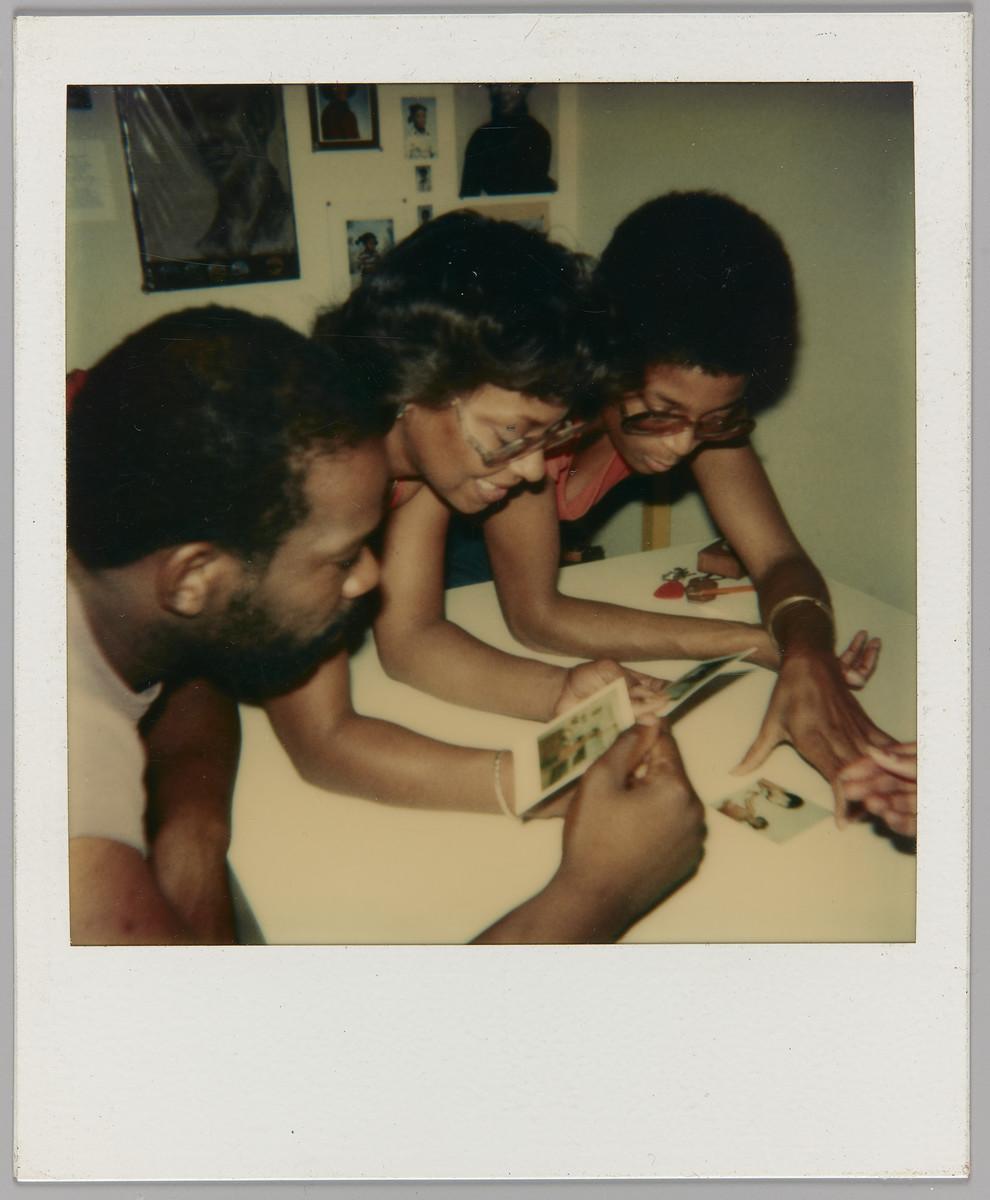
Unknown photographer. [Looking at Polaroids], 1980. Colour instant print [Polaroid SX-70], overall: 10.8 × 8.8 cm. Art Gallery of Ontario. Fade Resistance Collection. Purchase, with funds donated by Martha LA McCain, 2018. © Art Gallery of Ontario 2018/1113
What Matters Most: Photographs of Black Life enshrines the role of the family photograph in shaping Black identities. Co-curated by artist Zun Lee and AGO Curator, Photography, Sophie Hackett, the exhibition of over 500 instant prints drawn from the AGO’s Fade Resistance Collection underscores the moments that matter most in the everyday – births, deaths, portraits, graduations and family gatherings among them.
We commissioned six graduates of Black Pen, a Toronto-based literary program for emerging Black-identifying writers, to compose personal responses to one or more of the photographs on view in a style of their choosing. The Black Pen alumni were first given a guided tour of the exhibition, which proved inspiring for each of them, and the results blew us away.
A moving contribution by African-American poet and essayist Dawn Lundy Martin to the What Matters Most catalogue inspired this commission. She writes about the implications of the Fade Resistance Collection being acquired and placed on view at a major art museum. She then turns her reflections inward, analyzing two of her family photographs and revealing the complex narratives they represent.
Take a moment to read this essay by Omi Blue below.
Imaging the Subaltern
By Omi Blue
In the centre of the photograph are three adults who express kinship by their physical closeness. Together, shoulder to shoulder, they hold their memories, for now photographs, in their curious hands. Leaned over what appears to be a white acrylic table, they chart the past, present and the future. The three of them stand there in the warmth of the summer making monuments out of photographs that foretell the future and by fate, someone has documented the moment. On the walls behind them are photos of children still ripe in their youth and older ones broaching the shores of adolescence. The space behind them gives the impression of a house bearing life’s resultant stories both harrowing and tender.
This Polaroid, then, is a palimpsest of memory and prophecy. Behind this singular moment lays the constellation of events that brings any family together. Through our photography, we enshrine children in the springtime of youth and elders who’ve arrived at their terminal winter. Click by sacred click, we document the past and the future. In affirmation of life, we document our kinship and in the subtext of what we capture is all we hold dear. Thus, inherent in the image is the portal. Through a conjuration of light and shadow, we manifest our memory into form. Through photography, a moment can live on for eternity. Through a photograph, we gain the ability to travel across time and space, projecting our realities onto film. We carefully commit to memory our joys and losses. It follows then that through our photography, what matters most becomes obvious. Through our catalogue of memories we construct a counter-hegemonic reality. We collapse any sense of linear time and build a map of memories for the future. Our archive is evidence of our rebellion. All the ways that they tried to destroy us and failed. With the camera, we are able to create and document realities that we were led to believe did not exist. In our photography is but one way that we remake ourselves. This is the gift of the camera for peoples who have been rendered surplus by the state and its infinite institutions. We, the subaltern, offer ourselves a narrative counter to that deployed by the oppressive regime. In our memories, we become soft, joyful, even sensitive. As open as we ought to be, because, as bell hooks quotes in her germinal work All About Love, the search for love continues even in the face of great odds.
Omi Blue is a Jamaican writer weaving stories on stolen land currently known as Canada moving between Tkaronto and Tiohti:áke. Their artistic focus lies in documenting the Black Atlantic, with an emphasis on the Caribbean. They are surrendering to history as their ancestors tell it.
Black Pen is a Toronto-based literary program for emerging Black-identifying writers, founded by Nia Centre for the Arts. The program’s first six graduates published GRIOT: Sojourn into the Dark in 2022, their first chapbook of fiction and non-fiction. Read the writings of Yvvana Yeboah Duku, Adeola Egbeyemi, Onyka Gairey, Saherla Osman, Kais Padamshi and Omi Blue, all on Foyer.
![Unknown photographer, Chillin on the beach, Santa Monica [Couple on beach blanket]](/sites/default/files/styles/image_small/public/2023-04/RSZ%20WMM.jpg?itok=nUdDiiKr)
